SEED PRODUCTION: A Complex Journey to Product PERFECTION
By Jon Cooner
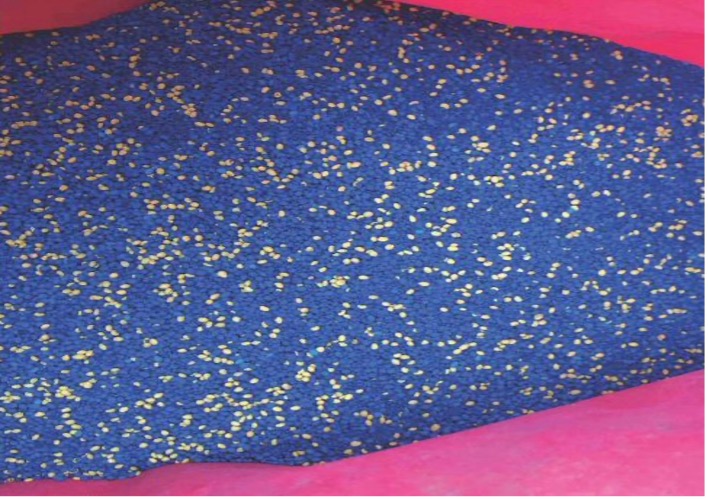 Much has been written in the Whitetail News Magazine over the years about the exhaustive research, development, and real-world testing that the Whitetail Institute puts its forages through before they’re allowed to display the Whitetail Institute name. Given that, its been long overdue to discuss all the hard work Whitetail Institute puts forth to produce the many tons of seed used in its blends. This article will shed light on that. You will quickly realize that it’s a little more complexed than just taking some random seeds designed for cattle and horses from the local COOP or AGRI Store and pouring them into a pretty designed bag with a deer logo. As you’ll see, our process is rigorous and extremely time consuming but necessary to ensure that Whitetail Institute products are the very best that the Whitetail Institute can make them.
Much has been written in the Whitetail News Magazine over the years about the exhaustive research, development, and real-world testing that the Whitetail Institute puts its forages through before they’re allowed to display the Whitetail Institute name. Given that, its been long overdue to discuss all the hard work Whitetail Institute puts forth to produce the many tons of seed used in its blends. This article will shed light on that. You will quickly realize that it’s a little more complexed than just taking some random seeds designed for cattle and horses from the local COOP or AGRI Store and pouring them into a pretty designed bag with a deer logo. As you’ll see, our process is rigorous and extremely time consuming but necessary to ensure that Whitetail Institute products are the very best that the Whitetail Institute can make them.
After the scientific research, development and field testing of all Whitetail Institute forage components and blends to determine optimum component percentages, attention turns to producing the massive volume of seed required to supply Whitetail Institute’s customers with the best possible food plot products available. It would take a book to fully describe the process of food plot seed production and the work that goes into producing the finest food plot seeds in the industry. We’ll hit the high points here, and as you’ll see, this is much easier said than done. It’s a far different and vastly more difficult process than just growing a forage crop in a food plot. A thorough understanding of each plant’s life cycle is required, and painstaking steps must be taken to ensure purity and attain the highest seed quality. The first step is to understand each plant’s life cycle, including how flowering is initiated and how flowers are pollinated, optimum seed production environment, nutritional requirements to optimize seed production, and what diseases and pests could negatively affect the seed crop. When this information has been reliably compiled, it’s time to find qualified seed growers. Here too, the requirements are vastly more stringent than growing crops to take to the local elevator. The best seed growers pay attention to every detail of the seed production process, listen and work closely with the Whitetail Institute, and complete all field activities required to produce a clean and genetically pure seed crop in a timely manner. When the grower is identified, a contract is written for the production of the seed which details requirements of seed purity, germination, genetic purity, seeding rate, etc. Whitetail Institute then provides the grower with their proprietary seed stock for planting the actual seed production field.
A Typical Seed Production Cycle:
Weed control is a major factor influencing seed production. Before the grower plants the stock seed, steps must be taken to control weeds and create a good seedbed. Weeds are removed through cultivation, and pre-plant herbicides are incorporated into the soil. Controlling weeds in the field is more effective than trying to clean weed seeds from the seed crop, since good seed is always lost when weed seeds have to be cleaned out of the seed crop in the cleaning plant. (More on the cleaning process later.)
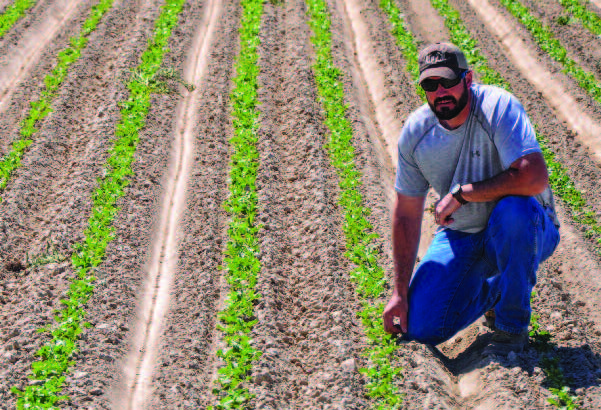
Photo 1
Shows young Whitetail Institute kale plants growing on beds in which no weeds are present. Seed crops are planted on beds, which allows for good irrigation and drainage. Rows in seed production fields are 24 to 30 inches apart, which is much wider than any food plot or field for forage production. This wide row spacing allows for close cultivation to control weeds prior to the crop covering the rows as well as maximum plant development and seed production.
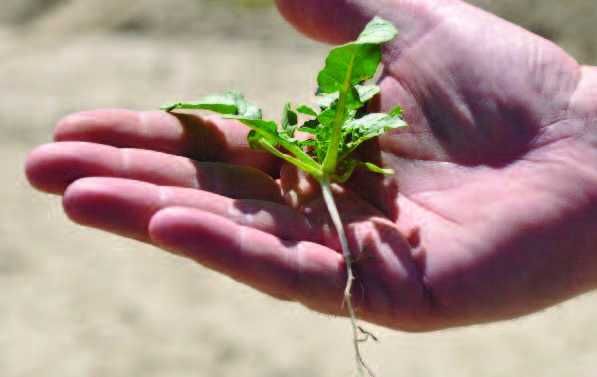 Photo 2
Photo 2
Note the root development in this young Whitetail Institute radish.
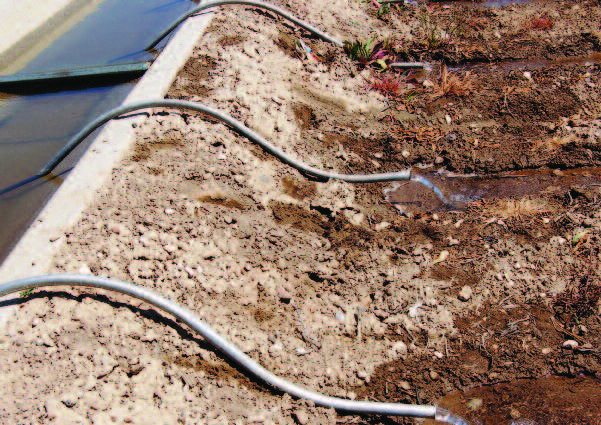
Photo 3
Because most of the seed for Whitetail Institute food plot products is produced in very dry environments, the fields are irrigated as soon as planting is complete. There are many different ways to irrigate fields including furrow irrigation, as pictured in Photo 3. Using siphon tubes, various types of sprinkler irrigation and, in some instances, fields are flooded. Irrigation is applied every seven to 10 days throughout the growing season depending on the crop and the environment. In between irrigations, fields are cultivated and sprayed to control weeds and insects.

Photo 4
Production field men and growers constantly watch for insect, weed and disease problems. As problems or potential problems are identified, the grower takes the appropriate action to control the issue.
A field man sweeps an alfalfa seed field looking for potential insect issues. While in the field, any weed or disease issues are also identified. If any problems are found, the field man coordinates with the grower to develop an action plan to address the issue. For crops requiring bees for pollination, the bees are brought to the field just before the field starts to flower. Growers know how many bees are required to set a full seed crop and bring that many bees to the field. This can be done at night when bees are less active, but can also be done in the early morning when temperatures are cool and there is little bee activity.
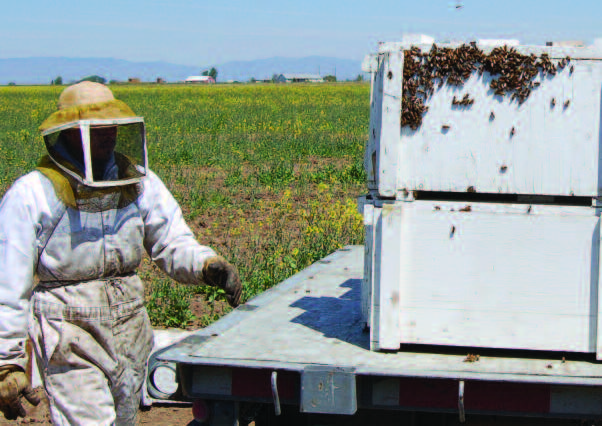
Photo 5
As seen in photo 5, when the bees are in or near the field, controlling insect pests becomes a sensitive process so that the insect pests are controlled without hurting the bees that are pollinating the crop. After the crop is fully set and the final seeds are filling and the seed crop ripens, bees are removed from the field and any final insect sprays are applied. The last seven to 10 days before seed harvest are perhaps the most intense of the entire cycle. While all the weed, insect and disease control are finished and the irrigation for the crop is done, this is the waiting time before harvesting the seed when Mother Nature can destroy a seed crop with hail, high winds or untimely rains. If everything goes well, combines harvest the crop and take it to the seed cleaning plant for the next part of the food plot seed production process.
Cleaning, Treating and Packaging Whitetail Institute Food Plot Products:
Harvested seed can be delivered in bulk to our seed house and unloaded into bins containing up to 3,000 pounds of seed. Seed can also be harvested directly into small bins in the field. Regardless of how the seed gets to the seed plant, a lot number is assigned to the delivered seed so the seed can be tracked back to the production field and followed through the cleaning and bagging process. Accurate record keeping is a key part of the whole process. The harvested seed is referred to as “dirt seed” to distinguish it from the final clean seed product.
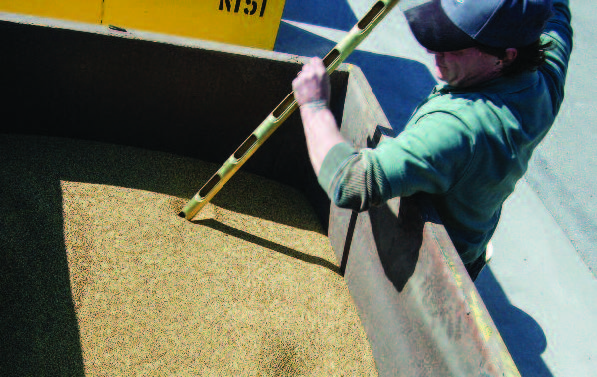
Photo 6
This image shows a dirt seed sample being taken from each bin. A composite sample is made for each complete lot. The composite sample will be used to determine the cleaning requirements for that specific lot of seed. The seed is securely stored to ensure that seed is protected and no cross contamination with other seed or other lots occurs.
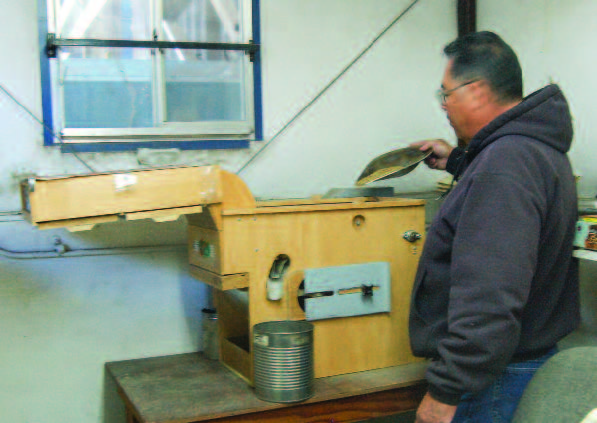
Photo 7 shows the composite sample being “docked,” which means it is being run through a small cleaning process that estimates the total clean seed and separates out weed seeds, chaff and other inert material. The resulting “docked sample” provides information necessary to clean the lot. Dirt samples are retained for two years as reference samples. Seed is first cleaned through five screen Delta cleaners and then by a gravity deck and rice rolls. Each bin that comes off the cleaning line is again sampled, and a mill check is performed to determine whether there is a need for additional or specialty cleaning. Depending on the specific issue, magnetic separators, indent cylinders or spiral separators may be used depending on the special cleaning needs.
Following cleaning, a composite sample is taken from the cleaned seed and sent to the seed lab where a registered seed technologist performs a complete purity and germination test. (Photos 8 and 9).

Photo 8
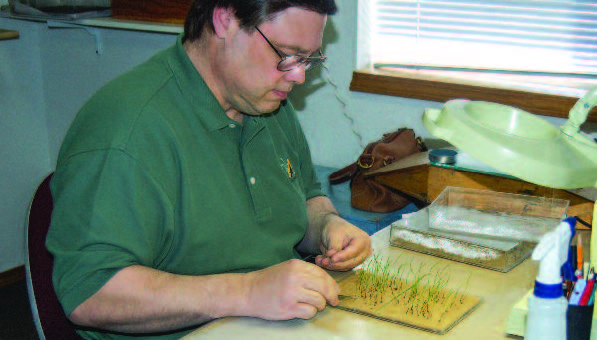
Photo 9
If the seed passes and meets Whitetail Institute’s seed quality standards, an official seed analysis report is made, and the seed is then stored in the small seed bins prior to treating, blending and packaging. If it does not pass, the seed is re-cleaned, and the conditioning process and analysis begins again. The last steps are mixing Whitetail Institute blends to the exact percentages that Whitetail Institute research has determined to be optimum to realize all the benefits for a particular product, and then packaging them. Each Whitetail Institute product has exact specifications regarding coating, inoculation and other seed enhancements. Care is taken during each step of the process to ensure customers receive the highest quality Whitetail Institute seed products for their food plot plantings. The packaging process starts with seed being weighed into each bag using a bag scale that has been checked by a certified scale agency for accuracy. Bags are also spot-checked to confirm weight accuracy. After the seed is put in the bag, it drops onto a conveyer belt where the bag is heat-sealed and then placed in a pallet liner prior to being shrink-wrapped for shipment. The care taken during the production and cleaning process ensures that only the highest quality seed is used in Whitetail Institute products.
Now you can see why it can take six to eight years or more for a new Whitetail Institute product to go from the idea stage to store shelves. Whitetail Institute’s strict and obsessive “attention to details” is the reason why Whitetail Institute products continue to be recognized as the gold standard of the food plot world. We are very proud and we enjoy every aspect of this process especially when we see the great photos and stories you share with us that result from use of Whitetail Institute products. We appreciate your continued support and input as we continue to develop food plot products to help you enhance the quality of the deer you hunt.
